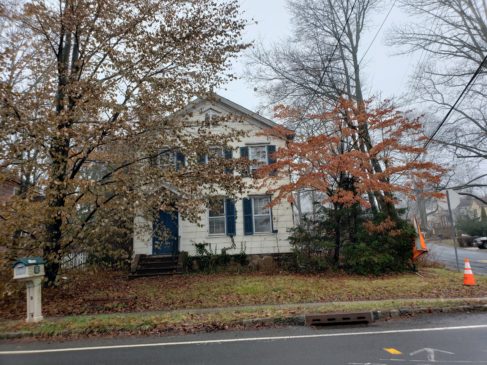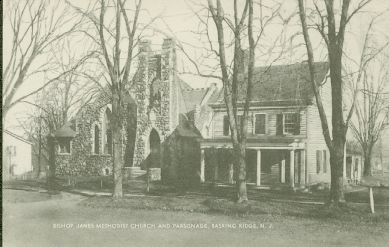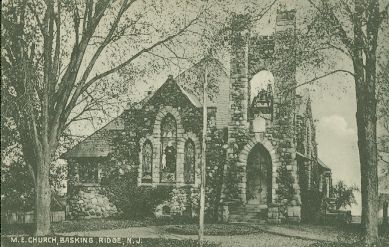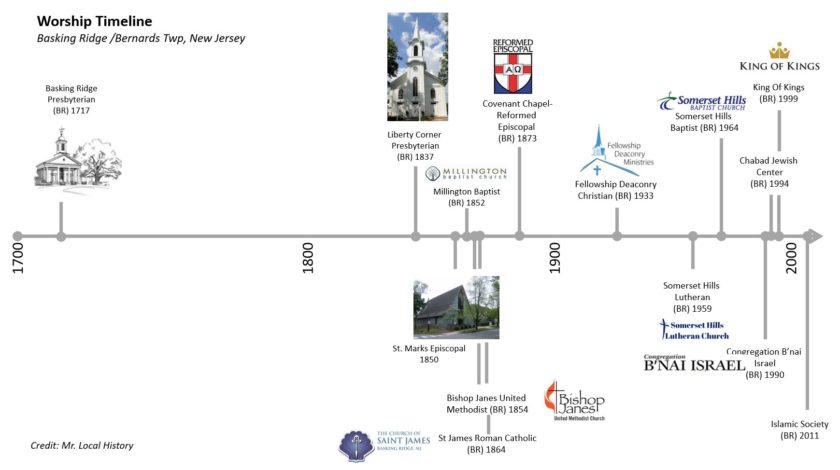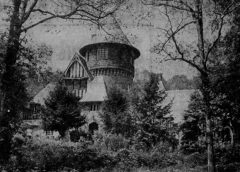Before we get started: The Methodist Church in the United States is 94% white, 92% third-generation American, 60% married, 69% believe in God, 42% attend church weekly, and 62% believe in hell. Several attempts were made in the twentieth century to reunite the Methodist Church with its founder’s own church – the Church of England. These were rejected by the Church of England’s General Synod in 1972. However, dialogue and informal relations continued. In 2003, a Covenant between the two churches was signed. This affirms each church as a true Christian church, carrying out the work of God, and commits each church to work more closely with the other towards full unity. Source: Pew Research
Edmund Storer Janes
Edmund Storer Janes (1807-1876) was born in Sheffield, Massachusetts, on April 27, 1807. He was the son of Benjamin and Sally (Wood) Janes, who raised a family of eight children: five sons and three daughters to maturity. The Janes family trace their origin back to William Janes, who was born in Essex, England, during the reign of James I, about the year 1610. The family name of Janes ties to the De Janes or De Jeanes and is of Norman or French origin. The name is still found in Kirtling, county of Cambridge, connected with the estates once belonging to Geoffrey de Janes about 1200 or 1204. Geoffrey de Janes was a crusader and helped to make Baldwin Count of Flanders King of Jerusalem.
Early Years
These English colonists had fled from the persecutions of Archbishop Laud to seek religious freedom in the American wilderness. Edmund and his family grew up in Salisbury, Connecticut as a child. It appears that Edmund began his first efforts at teaching when he was about seventeen years of age. In the summer of 1824, Edmund taught a district school at Ancram Furnace in Livingston’s Manor, Columbia County, N. Y.
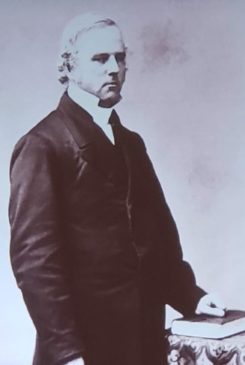
as a lawyer and admitted to the bar in 1827. Hearing the call to ministry, he joined the Philadelphia Conference in 1830. He was also a Doctor of Medicine, a Doctor of Law, and a Doctor of Divinity.
In 1829, he was led to change residence and moved to Bloomfield, New Jersey. It is here that he got his first appointment with the church. Licensed to preach in 1829, Janes’ first appointment was in Elizabethtown, New Jersey. He was reappointed in 1831, and in 1832, he was assigned to Orange, New Jersey.
At the Green Street Church in NYC, a young lady, Miss Charlotte Thibou, accompanied Dr. Howe to hear young Reverend Janes speak. Charlotte was born in Newark and raised in the Protestant faith. Miss Thibou’s parents were members of the Protestant Episcopal Church. Her acquaintance with Janes rapidly ripened into mutual affection. She and Edmund married in May 1835. Janes mentioned, “I got a fortune in my wife.” They both spent the rest of their lives serving God and the church.
1844 – Bishop Appointment
After placements in Philadelphia and New York, Edmund Janes was elected Bishop of the Methodist Episcopal Church in 1844 (just before the split over slavery), and he served 32 years. One estimate is that next to Asbury, he was the greatest bishop of the 19th century. He was highly regarded as an eloquent preacher, an able administrator, an indefatigable worker, a sacrificing servant of the Church, and a genuinely religious and Christian man.
Janes was described as “the youngest Bishop, small in stature, with a pleasant, round face and a musical feminine voice. He is an able and dignified presiding officer. His manners are easy, his head clear, and his decisions prompt and courteous. All classes felt and admitted the influence of his great character and Christ-like life throughout that region.”
At the General Conference of 1844, Janes and Leonidas Hamline became the last two men elected bishops by a united church; the next year, the Methodist Episcopal Church split north and south over slavery. At just 37 years old at the time of his election, Janes was the youngest man ever elevated to that post.
Bishop on the Mountain
In the book This is Bernardsville, Bishop Janes is recognized as the first to come to what later became known as “the mountain colony.” Bishop Janes built a lovely summer home in what was referred to as “the country” in Bernards Township. (Bernardsville was part of Bernards Township until March 6, 1924).
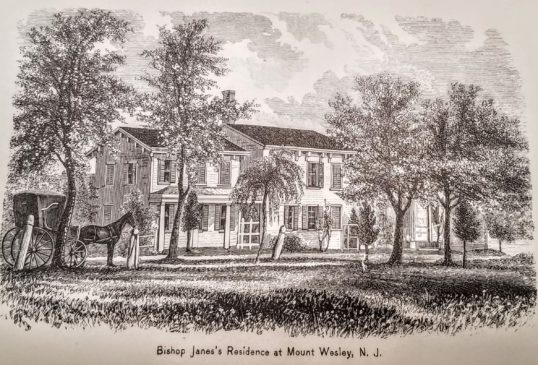
Source: The Life of Edmund S. Janes
” In the spring of 1849, after holding his Conferences, the Bishop settled his family for the
Rev. William Day, the young pastor of the Bernardsville and Basking Ridge charge.
summer and autumn at Mount Wesley cottage, near Mendham, New Jersey. The air of this hilly
region was very favorable to the health of Mrs. Janes and the children.” Mount Wesley was later acquired by Francis Oliver in 1870, who turned the white framed home into a summer boarding house, introducing the area to guests George B. Post and George Seney. Seney acquired the boarding house and changed the name to Highland House. He expanded the house into what became the Somerset Inn in 1877.
Bishop Janes purchased the Bernardsville home on Mendham Road, knowing there was much work to be done in the area. In 1851, he began building churches in Orange, Irvington, Bound Brook, Johnsonburg, and Basking Ridge. In 1854, he paid for the entire Methodist church in Bedminster.
The Basking Ridge United Methodist Episcopal Church
Bishop Janes United Methodist Church (renamed c1900)
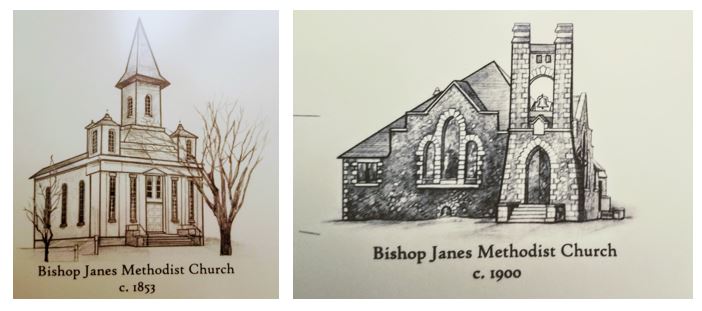
The history begins with the establishment of a church in the 1740s and continues into the late 1950s. The site of the Basking Ridge church is 22 South Finley Avenue (called initially Front Street) in Basking Ridge, New Jersey.
Other Methodist churches were in the area: Mount Horeb and Gladstone in the 1840s and Green Village in 1843. Bernardsville started at the Mine Mount schoolhouse in 1842, and the Bernardsville Methodist Episcopal church was erected in 1846 with the help of the New Vernon Methodists. The Rev. William Day of the Newark Conference was the pastor of Bernardsville and Basking Ridge, serving from 1853 to 1855 within the bounds of Mount Wesley, the Bishop’s country residence.
Janes had previously tried numerous times to use “The Academy” (The Brick Academy) as a venue for his sermons. To no avail, he did secure a private home just across the street from the current church to have his first “meetings” with William Day, overseeing the activities. In 1853, he bought the house across the street from Town Hall to use in the interim. At a meeting on June 2, 1853, at 8:00 pm, the Methodist Episcopal Church of Basking Ridge was formed. The founding trustees included Benjamin Smith, Roderick Mitchell, Daniel D. Craig, James U. Blazure, Bailey Brees, James Barton, and Isaac W. Keeler. The Reverend William E. Day was the church’s first minister. The church’s first pastor in Basking Ridge was William Day, 1853-1856. Day moved on in 1856 to the Newark congregation. It was mentioned at the time that Basking Ridge didn’t need another church “for shoutin’ Methodists who had a reputation for primitive emotional worship.”
In 1853, regular Methodist preaching was established in Basking Ridge, an adjoining town, when the Bishop bought a house and dedicated it to that purpose. The following year, the church was built mainly through his contributions and personal help. “We had only four male members at the Ridge, not one of means, when it was proposed to build the church. The contract for the building required that the stones for the foundation and basement should be placed gratuitously on the site by the friends of the enterprise.” The pastor found it impossible to generate sufficient community interest to do this.
The Bishop, returning after an absence at the Western Conferences, heard the pastor’s statement and said, “I will help you tomorrow.” Early the following day, as the pastor looked out of his study window, the Bishop was seen driving a double team of oxen, drawing a large cart loaded with stones which, with his own hands, he had gathered from the top of the mountain more than a mile distant (the area now known as Lord Stirling Stables). He invited the pastor to join him. For three days, they worked together in this way, carting stones.
Meeting Janes on the road, a Christian lawyer exclaimed,”Why, Bishop Janes, is that you? Drawing stones for your farm?” The Bishop replied, “We don’t draw stones for the farm, but we will draw a few for the Lord when needed.” “What does this mean?” inquired a wealthy farmer whose sympathies with the church enterprise were not in the least.”It means,” said the Bishop, “that the stones will be drawn–the church has got to be built.”
The Bishop’s example soon secured abundant stones, and the church was built. The bishop preached one of his most powerfully impressive sermons at the dedication.
Church Stones
That carting of stones had other good effects. A prominent citizen, a keen observer, not a Christian, said to the writer:” I have studied the character and life of Bishop Janes for these ten years. He is the best and most remarkable man I have ever known, but the best thing he has done for this community was the drawing stones for the church; for this reason–although here men have thought in driving oxen, it was necessary to make a great deal of noise, and that they must swear sometimes.
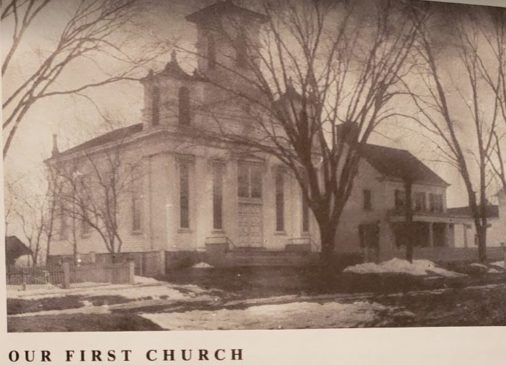
“Bishop Janes drove a double team for three days up and down Front Street, only speaking in low and gentle tones. Please tell him that by this, he has done more good than ever by preaching ten of his greatest sermons. I was myself much impressed by the Bishop’s quiet power over the oxen and the skill with which he controlled them and observed to him that they seemed to recognize episcopal authority”. He replied, ‘Oxen are most tractable creatures.'”
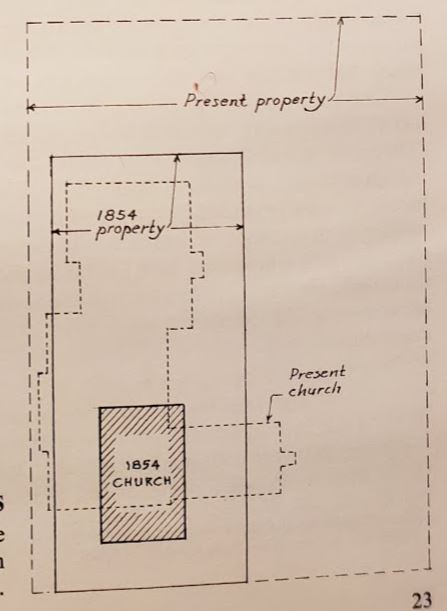
In 1896, the Reverend Joseph Appley began a six-year tenure at the church. A new church was designed, built, and dedicated on August 26, 1900, including an impressive stained-glass window noted as “a memorial” to Bishop Janes.
It should be noted that in 1867, the Church also had a parsonage on the southwest corner of Lewis and Maple Avenue (then called Elm Street). A meeting house stood directly across the street at the second house from the corner of Oak and Finley.
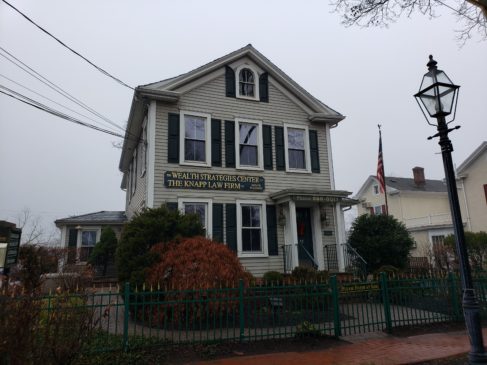
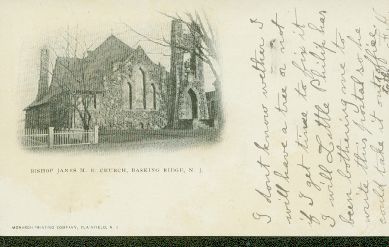
The Reverend R. Benjamin Garrison dedicated a larger annex and education building on October 17, 1954.
The church celebrated its centennial in June 1953.
Church Pipe Organs
One of the grandest investments in Bishop Janes’ church is its pipe organ. Purchased pre-owned in Pennsylvania from a theater in 1926, this organ replaced the original foot pedal reed organ and was dedicated on Labor Day weekend at the Friday service in 1926. All mechanical elements for the new organ were constructed at the PJM facility in Stowe, Pennsylvania. One of its signature products, the console is constructed of solid white oak with a cherry interior. It contains 32 levels of memory, record/playback, transposer, and MIDI capabilities. The speaking facade pipes comprise notes 1-9 of the Great Diapason and 1-9 of the Pedal Principal. Approximately 2300 man-hours were spent by 10 craftsmen custom-building this instrument.
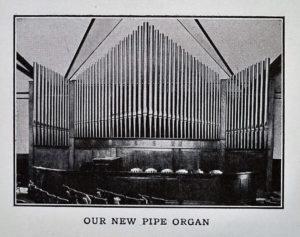
Reverend Mellburg Sr. died shortly thereafter, in 1926, and was buried in Evergreen Cemetery up the road on Oak Street. His house on Hillside Terrace was sold, and his mother moved to the M.E. parsonage with her son and his family.
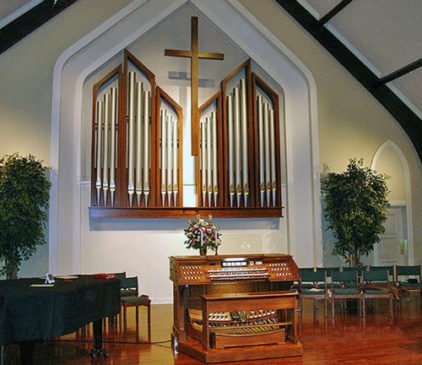
Bernardsville Church
In 1854, the Bishop had insisted upon the erection of a chapel at the ” Cross Roads” in Bernardsville. In January 1855, having a little leisure, he sallied forth among the Churches of South Jersey to collect money to relieve this small Church.
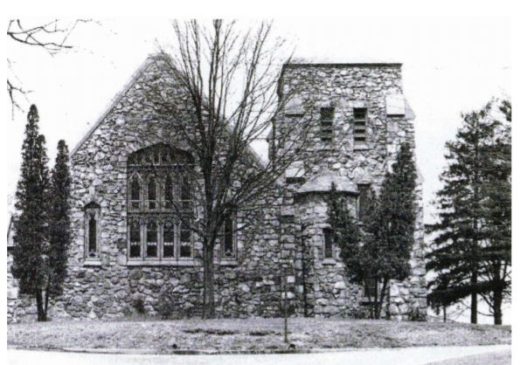
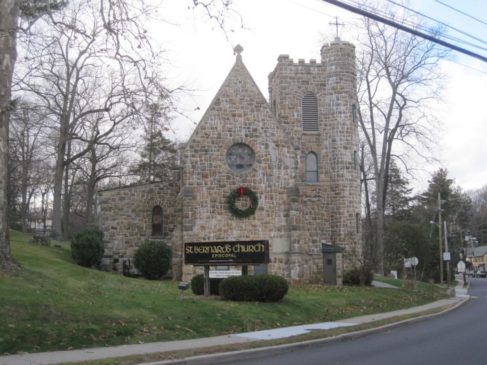
Although St. Bernard’s Church was founded in 1896, it didn’t open its doors in Bernardsville, NJ, until June 29, 1898. The article notes. “The Episcopal church adopts a Victorian adaptation of Baroque and Gothic style. British stained glass designer Charles Eamer Kempe’s crafted window of St. Bernard also hangs inside the church. While it might not be the biggest of churches, the mosaic combinations of Cahn stones give the building a beautiful and rustic look that has stood the test of time for almost two centuries.’’
The grounds of St. Bernard’s are currently undergoing a major transformation, as a 20-unit condominium project is being built in the former historic parish house on the site. As part of that project, developer Nat Conte of Bernardsville built a new parish house that recently opened near the existing historic church building.
Source: Bernardsville News – February 3, 2019
Janes Letters Highlighting the Somerset Hills
“We received your two letters on Saturday afternoon, and I am very glad to hear that you are in good health. We are all pretty well to-day, and nearly over our whooping-cough. Yesterday morning’s text was, ‘Continue in prayer.’ On Saturday Lewis and Mrs. Isaacs went to Morristown and were caught in the showers, as it was a rainy day, but they reached home in safety. On Sunday as we were leaving the church one of ‘Favorite’s’ shoes came off, so she could not go to
From a July 1849 letter from Daughter Charlotte to her papa Bishop Janes
Mendham in the afternoon. Lewy took her down to the black-smith Monday morning ; and yesterday afternoon Lewy, Lizzie, Tilly, Ellen, Katy, and myself went to pick cherries.
“I hope you are very well, and have had a pleasant journey back to Rockford again. Porter gave Katy a little kitten that she calls Rosa. She feeds it milk morning, noon, and night. It is very playful. We have a fine brood of young turkeys. Their color is white, black, and a light slate combined. They are eight days old to-day, and are very large. Our chickens are very mischievous. They eat off the cabbages and root up the beans. We have very fine raspberries, black, white, and red, which mamma enjoys very much. I must now bring my letter to a close.”
From Elizabeth to her father, Mount Wesley cottage, July 9, 1849.
“Indeed, I am now enjoying that quiet retirement for which I have so long sighed. We find the house pleasant and airy my room very agreeable. . . . And O what brilliant sunsets I daily behold sitting by my window! The birds sing all day long, and the flowers are blooming beautifully. I am literally surrounded with bouquets of flowers in my room. And dear little Lizzie invariably presents me with a nosegay of pinks and roses when I come down to my meals. The moonlight evenings this week are most tempting. I sat up till a late hour last night viewing the moon just in front of my window. My thoughts were sweetly soothing and solemn. While alone with God I was engaged in meditation and prayer. I feel that I am indeed encompassed with innumerable blessings, for which I never felt so much thankfulness nor appreciated so fully as at present. But it has always been my experience that ‘Thy gifts alone cannot suffice Unless Thyself be given.'”
From Charlotte Janes to Edmund in 1850
The Birth of the Methodists
Methodism, the 18th-century movement, was founded by John Wesley (1703-1791), who sought to reform the Church of England from within. The movement, however, became separate from its parent body and developed into an autonomous church. Under the leadership of George Whitefield and John Wesley, the movement grew rapidly among those who felt neglected by the Church of England.
Methodism was introduced into America by Irish immigrants whom John Wesley had converted. Along with Superintendent Thomas Coke, he helped Asbury organize the Methodist Episcopal Church in 1784, and Asbury and Coke allowed themselves to be called bishops.
In 1907, the Methodist New Connexion, the Bible Christians, and the United Methodist Free Churches joined to form the United Methodist Church; and in 1932, the Wesleyan Methodist Church, the Primitive Methodist Church, and the United Methodist Church came together to form the Methodist Church.
Bishop Janes & the Mountain Colony
The Janes’s home on Bernardsville Mountain was the launchpad to the area’s development. His Mount Wesley home was sold in 1870 and later became the Somerset Inn, George Seney’s most noted hotel on the mountain. In 1877, this hotel became “ground zero” for the rich and famous, earning the area the nickname “Banker’s Mountain.” You can say that Bishop Edmund Janes was the one who introduced the world to the Somerset Hills.
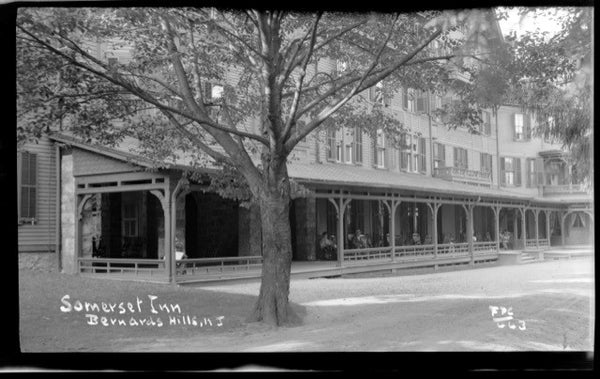
Additional Information
- Bishop Edmund James was never the pastor of the Basking Ridge church. William Day was the first pastor.
- John Wesley, the movement’s founder, was born on June 17, 1703.
- Edmund Janes was born on April 27, 1807, and died on September 18, 1876, at 69.
- Edmund Janes had a twin brother, the Rev. E. L. Janes.
- Edmund married Miss Charlotte Thibou. Miss Thibou’s parents were members of the Protestant Episcopal Church in 1834.
- Edmund & Charlotte had three children: daughter Sarah Elizabeth “Lizzie,” son Lewis Thibou “Lewy,” and Matilda Palmer (1847?). The children attended school at Basking Ridge, N. J, during the first four years of the Bishop’s general superintendency (1844-1848 TBC) and often played on the nearby sand hill.
- Lewis Janes married a Bernardsville girl.
- Lewis Janes is buried in the Basking Ridge cemetery.
- 1851 – Bishop Janes purchased the meeting house just across the street from the current church (2nd structure in from Oak Street)
- 1853 – The Basking Ridge Methodist Episcopal Church was organized overseeing Bernardsville until 1856.
- 1858 – Evergreen Cemetery on Oak Street was acquired.
- 1867 – The church’s first parsonage was purchased on the corner of Lewis and South Maple.
- Throughout the years, Bishop Janes donated more than $50,000 to the Methodist church.
- Edmund’s twin brother Edwin L. Janes founded the Hilton Church in Maplewood, NJ, and became its first pastor.
- Bishop Janes began his presidency of the Conferences in the spring of 1853 with the Providence Conference, New Bedford, Mass., April 13.
- Bishop Edmund James was the first Bishop of the New York area of the Methodist Episcopal Church. Bishop Janes dedicated the first church in the Bedford-Stuyvesant community of Brooklyn on October 15th, 1859. This church and its people have lived up to the strength of character and belief in liberty of, and for all, God’s people, as evidenced by the life of this great man.
- Banker’s Mountain – Reference to where Mount Wesley was built on Mendham Road on Bernardsville Mountain.
- Bishop Janes’s father, Benjamin, died on April 14, 1854
- Edmund James died in New York on September 18, 1876 (69) one month after his wife. She died on August 13, 1876 (67).
- Carl C. E. Mellberg served as pastor from 1924-1930 and is often cited as the Pastor who embraced the Ku Klux Klan.
- In 1939, the Methodist Episcopal Church became the Methodist Church.
- 1939 – the third organ was put in place at the church.
- 1975 – The church bell was re-installed to the c.1900 tower.
- In 2008, Bishop Janes United Methodist Church’s Board of Trustees requested that Bernards Township return the rights to the Potter’s Field section of Evergreen Cemetery to the church for the sole use of in-ground burials.
Research
We thank three excellent sources for our research:
- Basking Ridge Methodism Volume 1 – 1740-1953 by Edward A. Schroeder and Wayne Koppes
- The life of Edmund S. James – Henry Bascom Ridgaway – 1882 – ” We know the Bishop; let us also know the man.”
- New Jersey Country Houses – Volume 1 – Barry Thomson and Jack Turpin

More New Jersey Local History Stories
Original Publish Date: December 12, 2019
Updated: May 3, 2025

